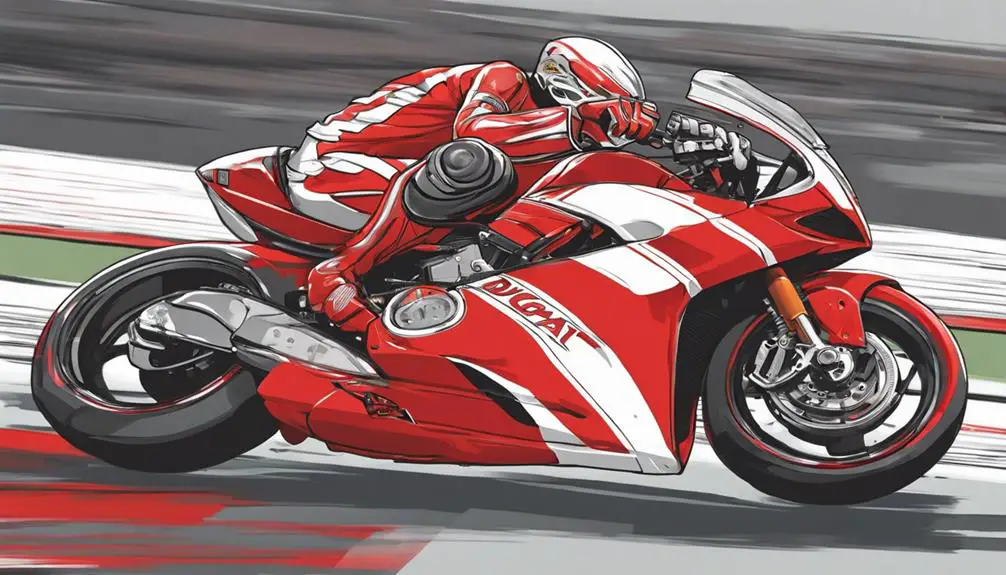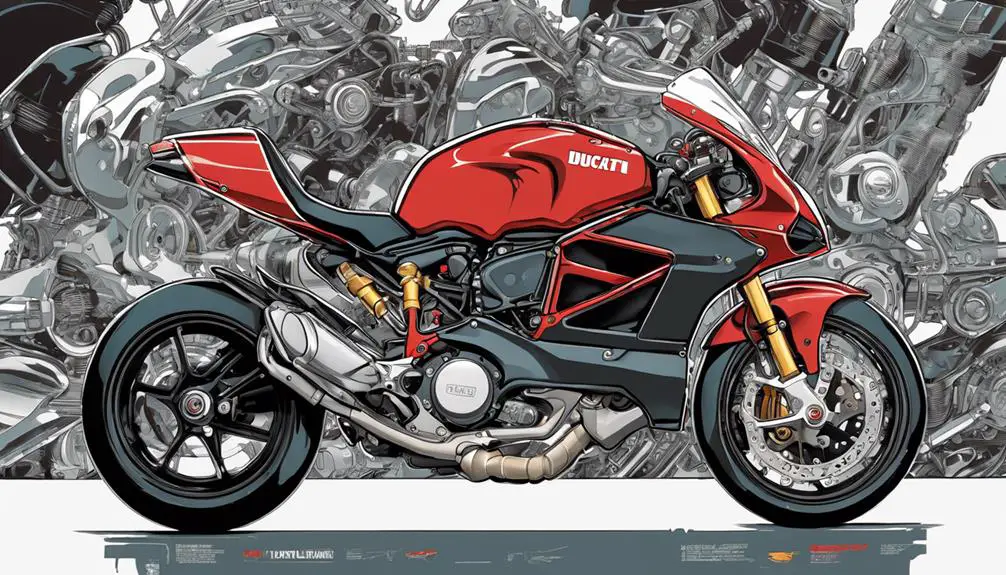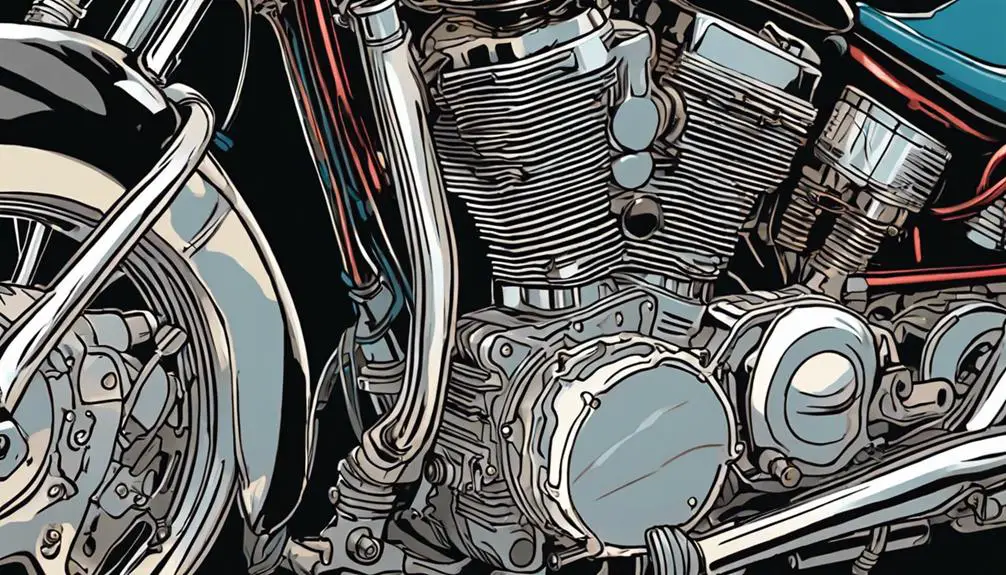When you're looking into the engine specs for racing bikes, it's crucial to understand how each component affects performance. You've got engine displacement, power output, and torque to take into account, each playing a critical role in how a bike accelerates and handles on the track. But that's not the whole story. Different manufacturers, like Ducati, have unique approaches to engine design that can greatly impact your racing experience. So, what do those differences mean for your choice of bike? Let's explore that further.
Key Takeaways
- Engine displacement (cc) significantly affects a racing bike's speed and acceleration capabilities.
- Power output, measured in horsepower (HP), determines the bike's top speed potential.
- Torque, expressed in foot-pounds, influences acceleration, particularly when exiting corners.
- A balance between engine size and weight is essential for optimal handling and performance.
Overview of Ducati Racing Bikes

Ducati's racing bikes are renowned for their powerful engines and cutting-edge technology, making them a favorite among competitive riders. When you hop on a Ducati, you're not just riding a bike; you're embracing a legacy of speed and precision. These machines are designed to push boundaries, allowing you to release your potential on the track.
You'll feel the rush as you navigate sharp corners and straightaways, knowing that every component is engineered for performance. The lightweight frames and innovative aerodynamics give you the freedom to maneuver with agility, while the advanced suspension systems absorb every bump in the road.
Ducati's commitment to racing isn't just about speed; it's about creating an experience that ignites your passion for the ride. You'll appreciate the seamless integration of technology, providing you with real-time feedback and control. This isn't merely a bike; it's a partner in your quest for liberation on two wheels.
Key Engine Specifications
When it comes to racing bikes, understanding key engine specifications is vital for maximizing performance and achieving your competitive edge.
You'll want to focus on a few important elements: engine displacement, power output, torque, and engine type.
Engine displacement, measured in cubic centimeters (cc), directly influences both speed and acceleration. A larger displacement typically means more power, but you need to balance that with weight for peak handling.
Next, consider power output, usually expressed in horsepower (HP). Higher horsepower means greater speed, but it's also important to make sure the bike can handle that power effectively.
Torque, measured in foot-pounds, affects how quickly you can accelerate. Higher torque allows for better performance during those critical moments of acceleration out of turns.
Types of Ducati Engines

Understanding the types of Ducati engines helps you appreciate how their unique designs contribute to performance and handling on the track. Ducati primarily uses two engine types: L-twin and V4.
The L-twin, also known as the 'Desmo' engine, features a 90-degree configuration, giving it a compact design that enhances agility. This engine's unique desmodromic valve system allows for precise timing, providing you with a thrilling, responsive ride.
On the other hand, the V4 engine delivers a different kind of power. With its 90-degree V configuration, it offers a wider power band and smoother acceleration, appealing to riders who crave speed on the straightaways. The V4 also incorporates a counter-rotating crankshaft, which helps stabilize the bike during hard cornering, allowing you to feel more confident and in control.
Both engine types embody Ducati's commitment to performance, emphasizing lightweight construction and cutting-edge technology. Whether you're tearing up the track or cruising the streets, knowing the differences between these engines empowers you to choose a bike that matches your riding style and liberates your passion for speed.
Performance Metrics
When it comes to racing bikes, performance metrics are essential for understanding what makes a bike truly competitive.
You'll want to pay attention to horsepower and torque, engine capacity options, and the weight-to-power ratio.
These factors directly impact your bike's speed, handling, and overall performance on the track.
Horsepower and Torque
Measuring horsepower and torque is essential for evaluating a racing bike's performance and overall capabilities on the track.
Horsepower represents the engine's ability to perform work over time, while torque measures the twisting force that propels you forward. Together, they determine how quickly you can accelerate and how well you can handle the bike.
When you're racing, you want a bike that delivers a thrilling experience, and that comes down to these two metrics. Higher horsepower means you'll reach top speeds faster, but if you don't have enough torque, you might struggle with acceleration off the line. This balance is critical for conquering tight corners and straightaways alike.
Think about it: you want a bike that not only screams down the straights but also launches out of turns with authority. That's where the magic of torque comes in. A bike with solid torque will feel more responsive, giving you the confidence to push your limits.
Engine Capacity Options
Engine capacity options play an essential role in determining a racing bike's performance metrics, influencing acceleration, top speed, and overall handling. When you choose a bike, you're fundamentally picking your engine's displacement, typically measured in cubic centimeters (cc). Higher displacement usually means more power, allowing you to hit those exhilarating top speeds and experience rapid acceleration out of corners.
For instance, bikes with engine capacities around 600cc often strike a balance between weight and power, making them fantastic for both amateur and professional racing. On the other hand, larger engines, like those over 1000cc, deliver a raw, thrilling power that can get your adrenaline pumping, but they also require a more skillful touch to handle effectively at speed.
Conversely, smaller engines, while potentially less powerful, can offer nimbleness and quick handling—ideal for tight tracks where agility trumps sheer force.
Ultimately, it's about finding the right engine capacity that aligns with your racing style and goals. So, embrace the freedom of choice, and let your spirit soar as you explore the exhilarating options available in the world of racing bikes!
Weight-to-Power Ratio
The weight-to-power ratio is an essential performance metric that directly impacts how quickly a racing bike can accelerate and maneuver on the track. Fundamentally, it measures the bike's weight against its engine power, showing you how efficiently the machine can perform. A lower ratio means more power per pound, which translates to faster speeds and sharper handling.
When you're seeking release on the racetrack, this ratio becomes your best friend. Imagine feeling the rush as your bike responds instantly to your commands. By focusing on achieving a balanced weight-to-power ratio, you can access the full potential of your racing bike, allowing for exhilarating cornering and explosive takeoffs.
To optimize this ratio, consider lightweight materials and powerful engines tailored to your racing style. Every pound you shed can translate into a boost in performance.
Common Engine Problems

Common engine issues in racing bikes can lead to significant performance setbacks and may require immediate attention. You might notice symptoms like poor acceleration, stalling, or unusual noises. These problems often stem from fuel delivery issues, such as clogged fuel filters or malfunctioning injectors. When your bike's engine isn't getting the right fuel mix, it struggles to perform at its best.
Another common culprit is overheating, which can result from low coolant levels or a faulty radiator. If you ignore overheating, you risk severe engine damage and costly repairs. Pay attention to any warning lights or temperature spikes—these are cries for help.
Additionally, worn piston rings or valves can cause a loss of compression, leading to sluggish performance. Regularly checking your compression levels can help you catch these issues early.
Maintenance Recommendations
To keep your racing bike performing at its best, regular maintenance is essential.
You should schedule oil changes and check tire pressure consistently to avoid any issues on the track.
These simple steps can make a significant difference in your bike's longevity and performance.
Regular Oil Changes
Regular oil changes keep your racing bike's engine running smoothly and efficiently, guaranteeing peak performance on the track. By staying on top of this essential maintenance, you free your bike from unnecessary wear and tear, allowing you to release its full potential.
Here's what you should focus on for oil changes:
- Frequency: Change your oil every 1,000 miles or after every few races, depending on your riding style.
- Type of Oil: Use high-performance synthetic oil designed for racing; it'll withstand high temperatures better than conventional oil.
- Filter Replacement: Always replace the oil filter with every oil change; a clean filter guarantees maximum oil flow.
Tire Pressure Checks
Maintaining the correct tire pressure is essential for ideal handling and performance on the track, as it directly affects your bike's grip and stability. When you hit the asphalt, you want that freedom of movement, and proper tire pressure helps you achieve it. It's not just about feeling the wind; it's about having full control over your ride.
Check your tire pressure before every track session. A simple gauge can be your best friend here. Most racing bikes recommend a pressure range, so make sure you stick to those numbers. Don't forget that temperature can affect pressure, so adjust accordingly if the day's heating up.
If your tires are under-inflated, you risk losing grip and increasing tire wear. On the flip side, over-inflated tires can lead to a harsh ride and reduced contact with the track.
Frequently Asked Questions
What Are the Benefits of Different Engine Configurations for Racing?
Different engine configurations offer unique advantages that can elevate your racing experience.
For instance, a V-twin engine delivers strong torque, perfect for quick acceleration, while an inline-four provides smooth power delivery at high RPMs.
You'll find that a parallel twin engine strikes a balance between power and weight.
Choosing the right setup can enhance your bike's handling and responsiveness, empowering you to release your full potential on the track.
How Do Racing Bike Engines Differ From Street Bike Engines?
Ever wondered why racing bike engines roar with such power?
Racing bike engines differ from street bike engines mainly in performance and design. They're built for speed, focusing on lightweight materials and high RPMs, while street bikes prioritize durability and comfort.
You'll find more aggressive tuning and less emphasis on fuel efficiency in racing engines. This means you'll experience raw power and acceleration, allowing you to feel the freedom of the open road like never before.
What Fuel Types Are Best for Ducati Racing Engines?
When you're choosing fuel for Ducati racing engines, consider high-octane options like racing fuel or premium unleaded.
These fuels provide better combustion efficiency and help maximize performance.
You'll want to avoid lower octane fuels as they can lead to knocking, which hampers the engine's potential.
Always remember to check the manufacturer's recommendations to guarantee you're releasing the full power of your bike while enjoying that exhilarating ride on the track.
How Do Weather Conditions Affect Engine Performance in Races?
Weather conditions can drastically affect your bike's performance during races.
If it's hot, your engine might overheat, leading to reduced power.
In rain, slick roads can cause poor traction, making you lose control.
Cold temperatures can thicken fluids, affecting lubrication and responsiveness.
You'll want to adjust tire pressure and settings based on the conditions to maintain ideal grip and power.
Staying aware of the weather can give you an edge in the race!
What Aftermarket Modifications Can Improve Racing Bike Engine Performance?
To boost your racing bike's engine performance, consider aftermarket modifications like high-flow air filters, aftermarket exhaust systems, and performance fuel injectors. These upgrades enhance airflow and fuel efficiency, giving you more power.
Don't forget about tuning your engine's ECU to optimize its performance.
Lightweight components can also improve acceleration and handling.
Embrace these modifications, and you'll release your bike's full potential on the track, feeling that exhilarating freedom every time you ride.
Conclusion
In the world of racing bikes, knowing the engine specs can really make a difference in your performance.
Whether you're tackling tight turns or pushing for top speed, understanding displacement, horsepower, and torque is key.
It's fascinating how even a small tweak can transform your ride.
So, next time you're at the track, remember: it's not just about the bike, but how well you know its engine.
Trust me, that knowledge could give you the edge you need!